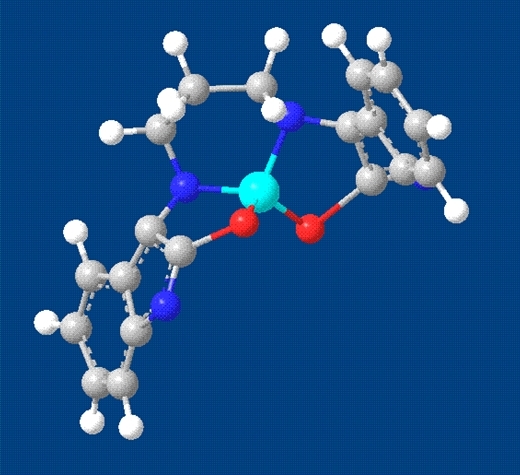

Complexes that associate essential metals with organic ligands could be used in cancer drugs (representation of organic compound metalized with copper / image from researcher's archive)
Complexes that associate essential metals with organic ligands could be used in cancer drugs.
Complexes that associate essential metals with organic ligands could be used in cancer drugs.

Complexes that associate essential metals with organic ligands could be used in cancer drugs (representation of organic compound metalized with copper / image from researcher's archive)
By José Tadeu Arantes | Agência FAPESP – Anti-tumor compounds with the potential to be used in drug manufacturing are being planned, synthesized and studied at the University of São Paulo’s Chemistry Institute (IQ-USP) in Brazil. These compounds are complex ions that penetrate cancer cells to attack their DNA and mitochondria. In the case of DNA, they cause oxidative damage after binding to its structure. In mitochondria, the organelles responsible for cellular respiration, the compounds decouple the respiratory process from the synthesis of adenosine triphosphate (ATP), the nucleotide that stores cell energy. This double attack strategy induces apoptosis (programmed cell death) and can lead to elimination of the tumor.
The university’s innovation agency has filed three patent applications for compounds of this type in the context of two Thematic Projects supported by FAPESP: “Complex species with potential for application in bio-organics, catalysis, pharmacology and environmental chemistry: conception, preparation, characterization and reactivity”, conducted from 2006 to 2010, and “Development of compounds with pharmacological or medicinal interest and of systems for their transport, detection and recognition in biological media”, begun in 2011 and scheduled to end in August 2017. The principal investigator for both projects is Ana Maria da Costa Ferreira, a Full Professor at IQ-USP.
Both projects are linked to the Center for Research on Redox Processes in Biomedicine (Redoxoma), one of the 17 Research, Innovation and Dissemination Centers (RIDCs) funded by FAPESP.
“Our starting-point was isatin, a metabolite of amino acids such as tryptophan found in plants, animals and humans. This compound of natural origin was modified in the laboratory via reactions with amines, and ions of essential metals such as copper, zinc and others were added,” Costa Ferreira told Agência FAPESP.
Isatin itself has recognized anti-fungal, anti-bacterial, anti-viral and anti-proliferative properties. The modifications boost its activity and create highly stable compounds that last a long time in the bloodstream and are not broken down before they penetrate cancer cells, to which they are attracted.
“Once they’re in the cellular environment, these metalized compounds bind to DNA and damage it through oxidative mechanisms, cleaving one or both strands. At the same time, they induce loss of mitochondrion membrane potential, altering its structure. The result is apoptosis, which doesn’t trigger inflammatory processes in the organism,” Costa Ferreira said.
After they first set out to understand in depth the mechanisms of action of these compounds, the researchers found that these compounds can inhibit certain proteins of great importance to cell survival. Particularly important are topoisomerase 1B, a nuclear enzyme that plays an essential role in maintaining DNA topology, and cyclin-dependent kinases (CDKs), a large class of proteins that regulate the cell cycle.
“Topoisomerase 1B reduces supercoiling in DNA,” Costa Ferreira explained. “It binds to the DNA, cuts one of the strands, unravels it to bring it in line with the other strand, and reanneals it back in. CDK1 and CDK2 regulate various phases of the cell cycle. By binding to these enzymes, our compounds inhibit their activity and impair cell development.”
Artificially metalized compounds are more active than their organic precursors because of electronic polarization caused by metal ions. In solution, the positive part (cation) separates from the negative portion (anion). The cation consists of the metal bound to an organic ligand. Because the ligand is lipophilic (soluble in fat), it can penetrate the cell membrane and carry the metal into the cell, triggering the activity described earlier.
The design of these organic ligands – classified as oxyindolamines – are based on compounds already studied in Phase II and III clinical trials and approved by the US Food & Drug Administration (FDA) as anti-cancer agents. Metallization significantly enhances their efficiency as they bind to or interact with DNA and proteins via both the metal and the coordinated ligand.
The researchers at IQ-USP have made several attempts to produce even more effective complexes. “One is a similar compound containing both copper and platinum, which act very differently inside tumor cells,” Costa Ferreira said. “Platinum binds to DNA like a clamp, hindering its activity. Copper cuts DNA by forming reactive species. Our idea was to combine the action of both to associate their effects.” The new compound was at least as effective as cisplatin, an FDA-approved metallopharmaceutical, against tumors such as melanoma and sarcoma.
Another more recent research line relates to the anchoring of active complexes in nanostructures designed to act as drug vectors or carriers.
“Nanostructures facilitate penetration of cells, enable smaller amounts of the active substance to be used, and promote its gradual release,” Costa Ferreira said. “All this points to the possible production of a more effective drug with fewer adverse side effects. Positive results have already been obtained with synthetic clay nanostructures.” These studies are being conducted in collaboration with Vera Regina Leopoldo Constantino, an associate professor at IQ-USP and a member of the research team for the ongoing Thematic Project.
Republish
The Agency FAPESP licenses news via Creative Commons (CC-BY-NC-ND) so that they can be republished free of charge and in a simple way by other digital or printed vehicles. Agência FAPESP must be credited as the source of the content being republished and the name of the reporter (if any) must be attributed. Using the HMTL button below allows compliance with these rules, detailed in Digital Republishing Policy FAPESP.





